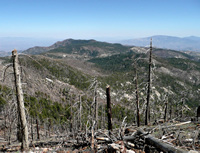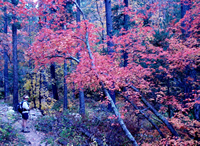Santa Catalina Mountains
 The Hitchcock Highway winds through the Santa Catalina Mountains for 27 miles ending at Mount Lemmon, the mountain range’s highest point. Photo by Charlie McDonald.
The Hitchcock Highway winds through the Santa Catalina Mountains for 27 miles ending at Mount Lemmon, the mountain range’s highest point. Photo by Charlie McDonald.
 Canyons at lower elevations have desertscrub vegetation dotted with saguaros. Photo by Charlie McDonald.
Canyons at lower elevations have desertscrub vegetation dotted with saguaros. Photo by Charlie McDonald.
 This is a view from Mount Lemmon looking over the top of dead trees burned in the Aspen Fire in 2003. As this picture shows, a forest fire may destroy one area, but leave a nearby area almost completely undamaged. Photo by Charlie McDonald.
This is a view from Mount Lemmon looking over the top of dead trees burned in the Aspen Fire in 2003. As this picture shows, a forest fire may destroy one area, but leave a nearby area almost completely undamaged. Photo by Charlie McDonald.
 This is a view underneath the canopy of a mixed conifer forest. Gambel oaks are producing the fall colors. Photo by Charlie McDonald.
This is a view underneath the canopy of a mixed conifer forest. Gambel oaks are producing the fall colors. Photo by Charlie McDonald.
 Wet canyons at high elevations often have bigtooth maples that produce brilliant fall colors. Photo by Charlie McDonald.
Wet canyons at high elevations often have bigtooth maples that produce brilliant fall colors. Photo by Charlie McDonald.
 The Cochise adder’s-mouth orchid (Malaxis porphyea) is a rare plant that is known from the Santa Catalina Mountains, several other Sky Island mountain ranges, and also New Mexico, Texas, and northern Mexico. It grows in very small populations that do not appear every year. Photo by Russ Kleinman at www.gilaflora.com.
The Cochise adder’s-mouth orchid (Malaxis porphyea) is a rare plant that is known from the Santa Catalina Mountains, several other Sky Island mountain ranges, and also New Mexico, Texas, and northern Mexico. It grows in very small populations that do not appear every year. Photo by Russ Kleinman at www.gilaflora.com.
High Point: Mount Lemmon, 9,171 feet
Elevation Change from Base: 6,371 feet
Vegetation at Highest Elevations: Douglas-fir–Mixed Conifer Forest
The Santa Catalina Mountains are a rugged range with steep slopes and deep canyons. The vegetation is strikingly diverse with mixed confer forests at the highest elevations and on north-facing slopes. Ponderosa pines predominate on many high elevation south-facing slopes. The higher elevation deep canyons, particularly those with running water, support lush hardwood forests of bigtooth maple, aspen, New Mexico locust, Arizona walnut, Gambel oak, and velvet ash. The Bullock Fire in 2002 and the Aspen Fire in 2003 burned much of the mountain range. Plants that grow from root sprouts like aspens, oaks, and shrubs are now regenerating in the former mixed conifer forests. It will be many years before the conifers, which must regenerate from seeds, dominate these forests again.
Special Places:
- Catalina Highway (General Hitchcock Highway): This 27-mile highway winds through the Santa Catalina Mountains ending near Mount Lemmon. It starts in the desert at 3,000 feet in elevation and ends in mixed conifer forest at 9,100 feet, taking you through all the vegetation types in between. The scenery along the way is breathtaking. Several Forest Service campgrounds and many hiking trails are accessible from the highway. The village of Summerhaven and the Mount Lemmon Ski Valley are near the end of the highway. The Aspen Fire in 2003 almost destroyed Summerhaven while the ski valley was untouched, even though Summerhaven and the ski valley are only a few miles apart. Summerhaven is being rebuilt and now has several new eating-places and shops.
- Sabino Canyon: The Sabino Canyon Recreation Area is a beautiful desert oasis, set at the base of the rugged Santa Catalina Mountains on the northern edge of Tucson. Here, two creeks with almost year-round flows drain the upper reaches of the mountain range. The canyons bring desert-loving plants like saguaro cacti into close proximity with water-loving plants like cottonwood trees. In 2006, a devastating summer flood changed the canyon forever. It washed the road away in some spots and buried it in tons of rubble in others. Picnic areas and other facilities were completely destroyed. Although changed, the beauty of this canyon remains and work is underway to rebuild much of what was destroyed.
- Pusch Ridge Wilderness: This wilderness area of 56,933 acres occupies much of the southwestern flank of the Santa Catalina Mountains. Elevations range from 2,800 to 8,800 feet spanning life zones from the Sonoran desert to subalpine forest. The wilderness has an extensive trail network accessible from both desert and high-mountain trailheads.
Special Plants:
- Agave schottii var. treleasei
- Allium gooddingii
- Hieracium rusbyi
- Malaxis porphyria
- Manihot davisiae
- Muhlenbergia duboides
- Muhlenbergia xerophila
- Packera neomexicana var. toumeyi
- Penstemon discolor
- Stevia lemmonii
- Thelypteris puberula var. sonorensis
- Viola umbraticola
Further Reading:


